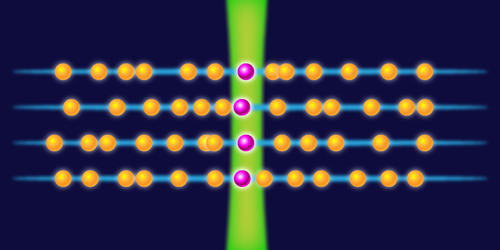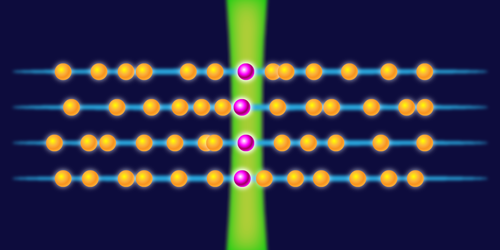Taking the Temperature of a Bose-Einstein Condensate
Ultracold atomic gases offer a route to creating quantum simulators that could solve quantum physics problems too complex for supercomputers. Reliable simulation requires the precise control of gas temperature. However, state-of-the-art techniques for measuring temperature either destroy the gas or work inefficiently at the 1-nK temperatures needed for simulations. Now, Mohammad Mehboudi of the Institute of Photonic Sciences in Spain and colleagues have developed a better scheme for taking the temperature of a 1D Bose-Einstein condensate (BEC) without perturbing the condensate.
Currently, researchers measure a BEC’s temperature by releasing the trapped atoms and monitoring how quickly the cloud expands, a technique known as time of flight. While accurate, this process “untraps” the atoms, destroying the BEC. To circumvent this problem, researchers have proposed nondestructive techniques. Mehboudi and colleagues now propose such a method that is more accurate than others. Their method uses impurities embedded in the cloud as temperature probes.
Using mathematical models, the team predicts that repeated measurements of the position and momentum of an impurity in the gas could reveal the BEC’s temperature. Such momentum measurements could be carried out through a time-of-flight technique that involves just the impurity. The team calculates that an ytterbium impurity in a 200-pK to 2-nK BEC made of potassium atoms could act as a temperature probe with a measurement error of less than 14%. That precision is comparable to destructive techniques and is an order of magnitude better than other proposed nondestructive methods.
Mehboudi and colleagues say that their technique should work for any BEC and could be extended to 2D and 3D gases. While the team has not yet attempted to implement their proposed strategy, they stress that their predictions incorporate experimentally feasible parameters for the gas and impurity.
This research is published in Physical Review Letters.
–Christopher Crockett
Christopher Crockett is a freelance writer based in Arlington, Virginia.





